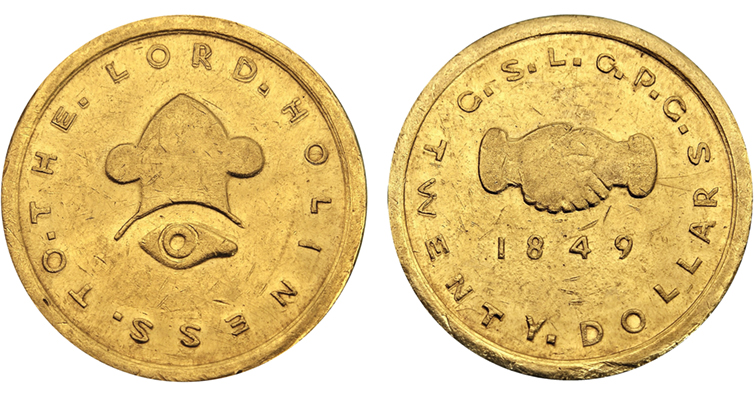Rare Mormon Gold Coin Resurfaces
A treasure locked away for more than fifty years has now resurfaced and this piece— an 1849 Mormon gold $20—is causing quite a stir in the numismatic community.
What’s more, the coin is in such a pristine state that even the condition of the Josiah K. Lilly gold coin collection in the Smithsonian Institution’s National Museum of American History pales in comparison.
“This new discovery coin is, in my opinion, superior to the Lilly coin, and as such [is] the finest known example of this historically important U.S. gold coin rarity,” said David Hall, president of Collectors Universe, parent company of the Professional Coin Grading Service (PCGS). “I’ve been paying attention to ‘Territorial’ gold for 46 years, and this is the finest Mormon $20 I have ever seen.” The piece was graded Mint State 62 by the PCGS.
While these $20 gold pieces are incredibly rare, there's an interesting legend that may have contributed to making the short-lived Mormon gold even more scarce.
Legend of Mormon Gold
In 1848, a settlement was erected atop the plains of Utah; it was called Great Salt Lake City. For two years, the community was without a currency and commerce was stilted. Leaders of the local church began to issue notarized paper bills for use in transactions but the Mormons found this an inefficient medium of exchange. So the President of the Mormon Church, Brigham Young, proposed a Plan B: the minting of precious metal coins. A small outbuilding would become the town’s new mint.
According to church records, the facility housed $2-and-1/2, $5, $10, and $20 gold pieces, with the $10 coins being the most scarce. But even those records are incomplete. After assessing the wear and tear of the original dies, some believe that more than fifty $10 pieces were struck. Still, this is an exceptionally low number in numismatic terms. This treasure trove, however, was not heavily guarded, and when night fell, it was not guarded at all.
Legend has it that persons unknown, passing through the city, learned of the mint through casual conversation with the locals. And under the guise of night, they forced their way into the mint and relieved the town’s people of this fortune.
Morning came, the mint appeared a bit more spacious, a wave of panic swept the town’s people and a team was quickly assembled to retrieve the stolen items. Investigators assumed that the bandits had chosen a passing wagon train as their means of escape.
The wagon train was discovered by the frantic, betrayed men and they made their way through it with a fine-toothed comb. They found nothing.
No one is sure of what happened to these bandits. Some say the men got lost in the desert and died of thirst. Others have no time for conversation, they are busy scouring the plains, hoping to return richer.
Today, these coins would be worth almost $100,000—each.
More About Mormon Gold
For a bit of background, according to The Official Red Book guide book of American coinage,
"The first name given to the organized Mormon Territory was the 'State of Deseret,' the last word meaning 'honeybee.' The beehive, which is shown on the reverse of the five-dollar 1860 gold piece, was a favorite device of the followers of Joseph Smith and Brigham Young. The clasped hands appear on most Mormon coins and exemplify strength in unity. HOLINESS TO THE LORD was an inscription frequently used.
Brigham Young was the instigator of the coinage system and personally supervised the mint, which was housed in a little adobe building in Salt Lake City. The mint was inaugurated late in 1848 as a public convenience."
This last line is of particular importance: in the "Wild West" era of settling the western part of the country, trustworthy banking services were hard to come by, as was hard money. For this reason, a number of private "territorial gold" pieces—in addition to the Mormon gold—circulated around the West in place of coins from the U.S. Mint. Like U.S. gold coins of the time, they were struck in denominations of $2.50, $5, $10, and $20. (Many of them closely resemble the official government issues.) These gold pieces are today extremely rare and thus highly collectible.
The opinions and forecasts herein are provided solely for informational purposes, and should not be used or construed as an offer, solicitation, or recommendation to buy or sell any product.

